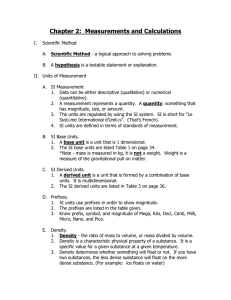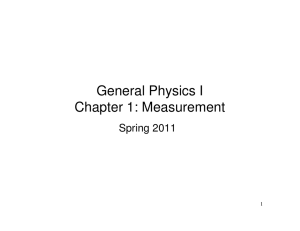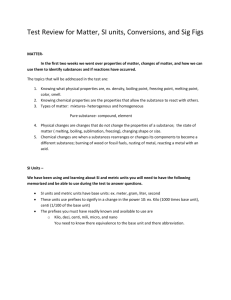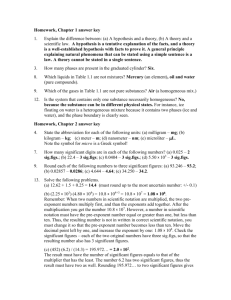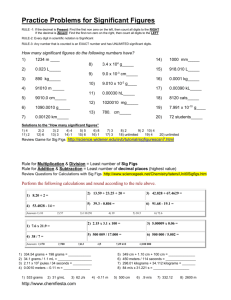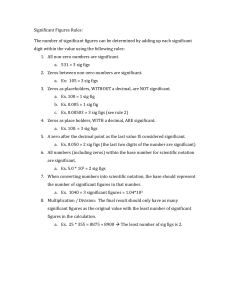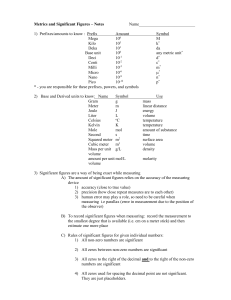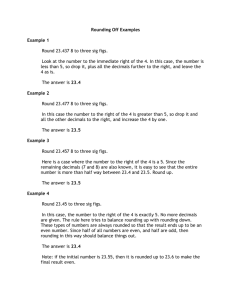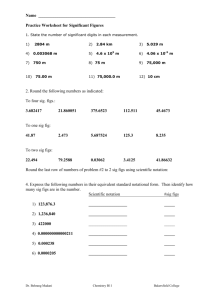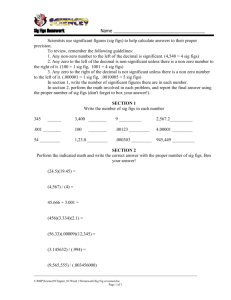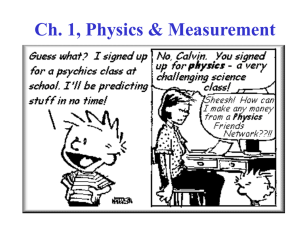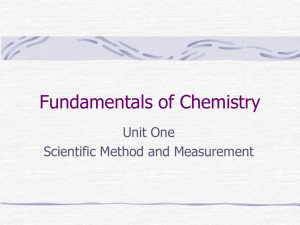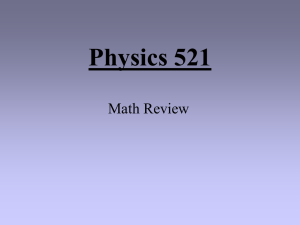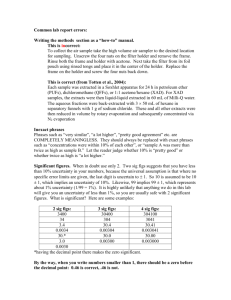Chapter 2: Measurements and Calculations
advertisement
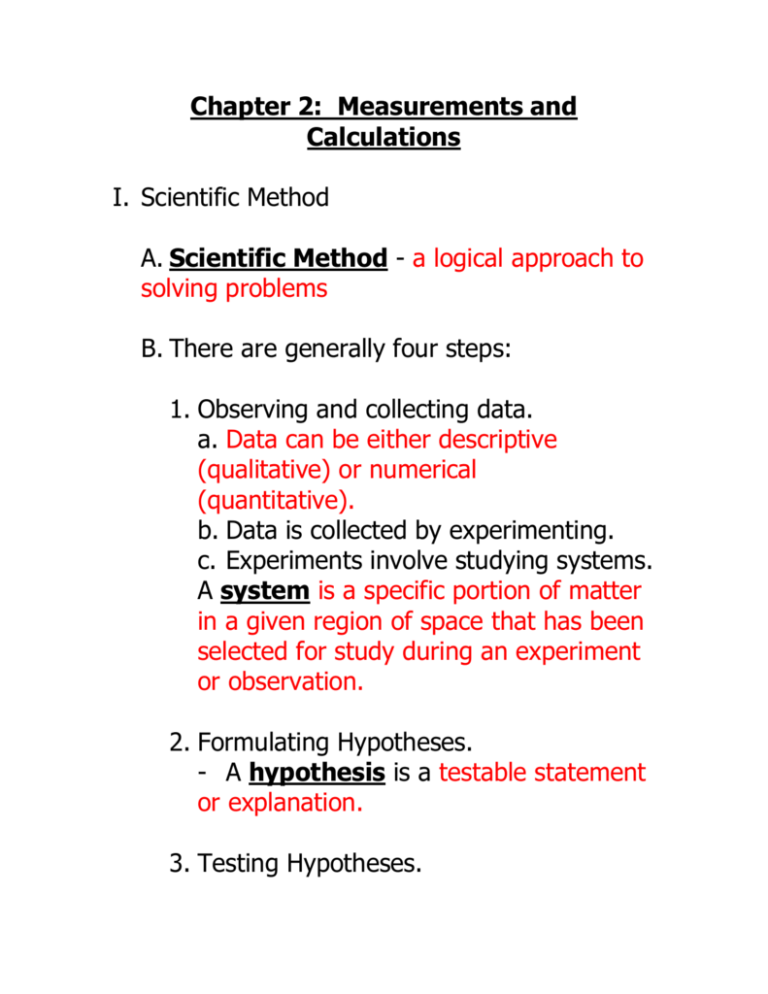
Chapter 2: Measurements and Calculations I. Scientific Method A. Scientific Method - a logical approach to solving problems B. There are generally four steps: 1. Observing and collecting data. a. Data can be either descriptive (qualitative) or numerical (quantitative). b. Data is collected by experimenting. c. Experiments involve studying systems. A system is a specific portion of matter in a given region of space that has been selected for study during an experiment or observation. 2. Formulating Hypotheses. - A hypothesis is a testable statement or explanation. 3. Testing Hypotheses. a. Requires experimentation that either proves or disproves the hypothesis. b. If the hypothesis is proved move onto the next step. c. If the hypothesis is disproved, return to step 2. 4. Theorizing. a. Explaining the phenomena being studied by constructing a model. b. The results are then published, and sent to other scientists. II. Units of Measurement A. SI Measurement 1. Data can be either descriptive (qualitative) or numerical (quantitative). 2. A measurement represents a quantity. A quantity: something that has magnitude, size, or amount. 3. The units are regulated by using the SI system. SI is short for “Le Système International d’Unitès”. (That’s French). 4. SI units are defined in terms of standards of measurement. B. SI Base Units. 1. A base unit is a unit that is 1 dimensional. 2. The SI base units are listed Table 1 on page 34. *Note - mass is measured in kg, it is not a weight. Weight is a measure of the gravitational pull on matter. C. SI Derived Units. 1. A derived unit is a unit that is formed by a combination of base units. It is multidimensional. 2. The SI derived units are listed in Table 3 on page 36. D. Prefixes. 1. SI units use prefixes in order to show magnitude. 2. The prefixes are listed in the table given. 3. Know prefix, symbol, and magnitude of Mega, Kilo, Deci, Centi, Milli, Micro, Nano, and Pico. E. Density. 1. Density - the ratio of mass to volume, or mass divided by volume. 2. Density is a characteristic physical property of a substance. It is a specific value for a given substance at a given temperature. 3. Density determines whether something will float or not. If you have two substances, the less dense substance will float on the more dense substance. (For example: ice floats on water) 4. Because it is characteristic of a substance, density can be used to determine the identity of a substance. F. Conversion Factors. 1. A conversion factor is a ratio derived from the equality between two different units that can be used to convert from one unit to the other. 2. Dimensional Analysis: A mathematical technique that allows you to use units to solve problems involving measurements. 3. To derive a conversion factor, you need to know the relationship between the two quantities. (For example: 1 dollar = 4 quarters). When this relationship is known, divide both sides by one of the sides. The result is your conversion factor. III. Using Scientific Measurements. A. Results vary with every measurement. Therefore we have to discuss uncertainty in measurements. B. Accuracy vs. Precision 1. Accuracy - refers to the closeness of measurements to the correct or accepted value of the measured quantity. 2. Precision - refers to the closeness of a set of measurements to each other. 3. A dart board is the best explanation of this. Figure 8 on page 44. 4. Percent error is calculated by subtracting the experimental value from the accepted value, dividing the difference by the accepted value, and then multiplying by 100. Negative values are OK. 5. Error in measurement must be reflected in the reading. Practice by reading a ruler. This leads to significant figures. C. Sig Figs. 1. Significant Figures for a measurement consist of all the digits known with certainty plus one final digit, which is somewhat uncertain or is estimated. 2. Rules for determining the number of sig figs in a measurement are in Table 5 on page 47. 3. Rules for rounding to a specific number of sig figs are in Table 6 on page 48. 4. Rules for math operations depend on the math operation used. Do the operation, then round to the correct place using the rules. a. Add/Subtract: round answer to fewest number of places to the right of the decimal point. b. Multiply/Divide: round answer to the fewest number of sig figs. 5. When using conversion factors round the same number of sig figs as are in the original number. D. Scientific Notation. 1. In order to use numbers that are really large or really small we use scientific notation. 2. The form is M * 10n. M is determined by writing all of the sig figs in order, then place the decimal point so that the number is between 1 and 10. n is determined by counting the number of places that the decimal point is moved. If you moved it to the left n is +. If moved to the right n is -. 3. When adding or subtracting the operation can only be performed only if the value of n is the same. If they are not, make them the same. 4. When multiplying, perform the operation on both M values and then add the n values. 5. When dividing, perform the operation on both M values and then subtract the n values. E. Proportionality 1. Two quantities are directly proportional to each other if dividing one by the other gives a constant value. This graph would be a straight line. (y=mx+b) 2. Two quantities are inversely proportional to each other if their product is constant. This graph would be a hyperbola. (y 1/x)
